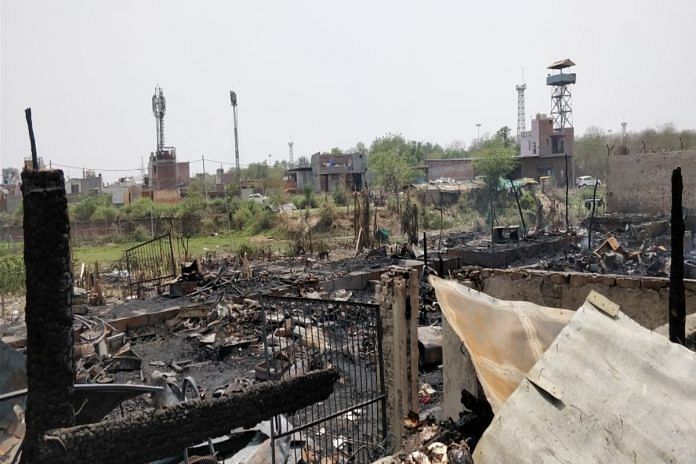About 40,000 Rohingya refugees live in Delhi, Jammu, Hyderabad, Jaipur etc., and face ‘dismal’ living conditions and health risks.
New Delhi: In the early hours of Sunday, a fire broke out in a camp for Rohingya refugees in Kalindi Kunj in the national capital, destroying the belongings, documents and homes of 46 families.
The 226 people whose homes were burned down at the camp have been moved to a temporary camp, but without any guaranteed provisions to prevent a similar tragedy from recurring. According to the South Asia Human Rights Documentation Centre (SAHRDC), most Rohingya settlements are “overcrowded and at risk of fires and public health risks”.
While some Rohingya families live in rented accommodation and therefore have slightly better living conditions, most refugees and asylum-seekers live in urban or semi-urban shanties built out of corrugated iron, timber, branches, plastic sheets, packaging materials and mud.
Rohingyas in India
The Rohingya Muslims, who are from the Rakhine State in northern Myanmar, have been exiting the country for decades in search of asylum. Described as the “world’s most persecuted minority”, the most recent exodus of the Rohingyas happened in August 2017, following a military crackdown.
There are an estimated 40,000 Rohingya refugees in India, although according to the United Nations High Commissioner for Refugees (UNHCR), only 17,500 are registered through its office in New Delhi.
Rohingyas live across different locations in India, such as Delhi, Jammu, Haryana, Hyderabad and Jaipur, the UNHCR told ThePrint.
“Each case is individually assessed by the office and a refugee card is issued only after establishing the applicant’s ethnicity as that of a Rohingya, and the potential risk she or he faces upon return to Myanmar,” said Roshni Shanker, founder of the Migration & Asylum Project of the Ara Trust, which provides legal assistance to refugees in India.
Living conditions
There are no government initiatives to provide shelter to the Rohingyas. As a result, settlements have cropped up in free spaces, such as street corners, beside train tracks, under bridges, and beside major highways.
Delhi is one of the main settlement areas for the Rohingya refugees, and has five big unofficial camps located in areas like Jasola and other sites along the banks of the river Yamuna. Many of them share living spaces with migrant labourers from Bihar and Assam, like in Jasola and Shaheen Bagh.
However, the largest settlement is in Jammu, where the Rohingyas have to face local hostility in addition to difficult living conditions. Ads in local newspapers have been calling for their deportation, and they have been considered a “security threat”. Local residents in Jammu and Kashmir have even threatened to “identify and kill” Rohingyas.
There are an estimated 8,000 Rohingya refugees in Jammu, where they live in shanties on the outskirts of the city, without water supply or electricity. One shanty or ‘jhuggi’ costs Rs 500-800 per month, and electricity is provided at an additional cost of Rs 200.
Hyderabad has the second largest settlement. The UNHCR puts the number of camps in the city at 12. Other estimates put the Rohingya population in Hyderabad at 7,000, of which 3,800 have refugee cards issued by the UNHCR. Sheds in Hyderabad cost Rs 1,000 a month without any electricity. The city is also the only one in India to have a school set up for Rohingya children, which was initiated by local NGOs and the UNHCR.
Apart from Delhi, Jammu and Hyderabad, Rohingyas also live in Jaipur and Mewat, Haryana. There are approximately 80-120 Rohingya families in Jaipur.
The settlements usually do not have access to basic amenities, and the refugees have to create these facilities up themselves. The camp that burned down, in Kalindi Kunj, was originally set up by an NGO in 2012. According to an internal note published by SAHRDC in January 2018, living conditions were “dismal” and “sub-human”. The unofficial camp was cramped, and the community was living amidst garbage.
The Rohingyas also face several health risks, and are exposed to diseases and infections. The camps along the banks of the Yamuna have to deal with snakes and other reptiles due to proximity to the river. The camp in Jasola has a few makeshift bathrooms, located outside the camp, next to a sewer. (Incidentally, Rohingya refugees across Asia are facing a public health crisis.)
For their livelihood, the Rohingyas tend to go into informal labour, because most of them do not have refugee cards and language acts as a barrier. Common jobs, according to SAHRDC, are rag-picking, selling vegetables, daily-wage labour work, and selling cigarettes. Children in the Rohingya community do not have education opportunities, and are often forced to work.




So now we Indian citizens are responsible for the “living conditions” of these PARASITES ?
Our people starve and live in poverty but the vomitious liberal numbskulls cry crocodile tears about these free loaders and parasitical infection called “rohingya” ?
Why are they in this country in the first place ? They cross from Bangladesh into India – a country which they face no persecution in – yet apparently they qualify as “refugees” ? Is Bangladesh persecuting these Rohingya now ?